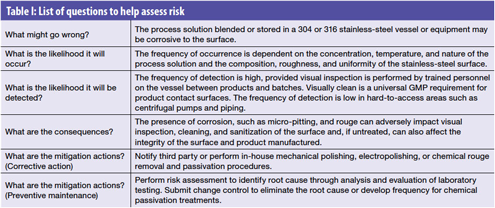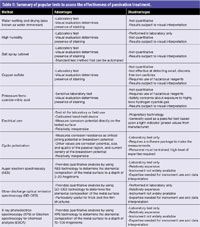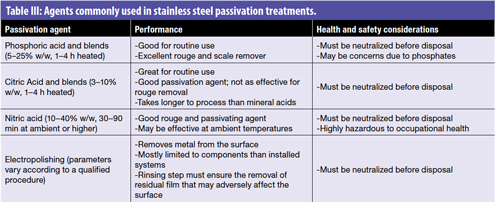News
Article
Pharmaceutical Technology
A Risk-Based Approach to Stainless Steel Equipment Maintenance
Author(s):
Laboratory tests can determine critical cleaning parameters for passivation treatments used to prevent rouge on GMP stainless-steel equipment.
Hywit Dimyadi/shutterstock.com

Stainless steel is usually the preferred substrate for good manufacturing practice (GMP) applications, and it constitutes the majority of GMP product-contact surface areas. The austenitic stainless-steel series (e.g., 304L and 316L) has been popular in pharmaceutical applications because of its high stain and corrosion resistance and affordability. Although stainless steel is named “stainless”, it is really “stain resistant”. This property comes from its ability to naturally form an oxide-rich, passive layer on the surface.
Passivation is a process in which a passive layer forms on the stainless-steel surface; this layer occurs naturally in the presence of oxygen when the surface has been cleaned of exogenous matter (1–3). The passive layer on the stainless-steel surface becomes the primary means of protection to prevent corrosion. Stainless steel can corrode, however, when the chromium-to-iron ratio has been significantly reduced, resulting in the oxidation and subsequent release of iron oxides that form deposits on surfaces.
Rouge is the commonly used term for the visible corrosion product of stainless steel; it can be composed of several forms of iron oxides, with ferric oxide being the predominant form (4–7). Rouging is typically found in water generation systems, process tanks, and pipeline systems that are routinely exposed to corrosive solutions. Rouge seems to be a common problem. Regulatory agencies such as FDA have cited in at least one warning letter that corrosion is unacceptable in direct-contact pharmaceutical systems (8). The reasoning is that rouge on product-contact surfaces can create an environment for process residues and microbes to tenaciously adhere to the rouged area and become more difficult to clean and sanitize (9-11). Residues and microbes might also reside within the rouge layers, where the routine cleaner and sanitizer may not be able to penetrate.
Preventive and corrective maintenance
Considering the risk associated with rouged surfaces, manufacturers would benefit from focusing more attention on treatments that prevent rouge from happening. Some companies take a reactive approach and wait until rouge has been detected or has impacted production before taking corrective action. Process attributes such as elevated temperature, extreme pH solutions, or surface damage (e.g., from poor quality welding) can corrode stainless-steel surfaces (4-7). If a process or surface condition is expected to lead to corrosion at some point during the life of the equipment, then an effort should be made to investigate and prevent that corrosion from occurring.
Unlike preventive maintenance, which is done to mitigate the cause of the potential problem or undesirable situation, corrective maintenance is done to correct a problem or fault once it has been detected. With a stainless-steel preventive maintenance procedure, for example, an operator knows exactly what needs to be done at a predefined schedule. On the contrary, in the case of a corrective maintenance, the critical parameters and overall procedure would depend on what is found. Corrective maintenance often requires evaluation of the severity of the rouge problem before any treatment can be recommended. This evaluation is referred to as a risk assessment, and includes a review of the potential impact to the patient, product, personnel, and equipment (12). Once the rouge is formed, there may be unknown variables associated with it and correcting the problem typically takes much longer than a preventive task. Many published references about stainless-steel corrosion are focused on corrective maintenance (3–11, 13–15).
When assessing the risk of the corrosion or rouge to the quality of the next product or batch, one should ask the questions about risk and mitigation actions summarized in Table I.
Table I. List of questions to help assess risk. Click to enlarge.

Passivation
There is no globally accepted test to guarantee that a stainless-steel surface has been adequately passivated. Generally, when stainless-steel equipment has been exposed to a passivation treatment, some documentation should be generated describing the passivation procedure with emphasis on the critical parameters. A test matrix has been suggested to be used as a guide for acceptance criteria and to confirm that a surface is passivated (3). The overall scope of these test methods is to either verify that the surface has been passivated by removal of exogenous matter (e.g., free iron or hydrophobic films) or by direct measurement of the quality of the passive layer. Table II summarizes the advantages and disadvantages of common passivation test methods (2–3). Representative coupons of similar material and finish to the production equipment can be used to validate a passivation protocol.
Table II. Summary of popular tests to assess the effectiveness of passivation treatment. Click to enlarge.

Passivation treatments are dependent on the chromium content, surface finish, and machinability characteristics of the grades in each family of stainless steel. The chemical treatment should help restore the inert oxide layer in a consistent, faster-forming passive layer than found naturally. Passivation treatment using citric acid blends and phosphoric acid blends are highly effective for a large number of stainless-steel families. The conventional nitric acid passivation methods and others are summarized in Table III. The choice of passivation chemistry and method depends on the acceptance criteria imposed by the end-user as well as corporate, local, and national waste regulations. Typically, a passivation process includes the following steps:
- Alkaline cleaning (either single pass or recirculated) to remove all contaminants, oils, and foreign material.
- Water rinse
- Acid treatment (either single pass, recirculated, or immersed) to dissolve any free iron and sulfides and to expedite the formation of the oxide layer
- Water rinses
- Drying
- Visual inspection and tests, as appropriate.
Table III. Agents commonly used in stainless steel passivation treatments. Click to enlarge.

Laboratory test model and verification of test conditions
Laboratory testing has been successful in determining critical cleaning parameters for passivation of stainless-steel surfaces. A formulated phosphoric/citric acid detergent and a formulated citric/oxalic acid detergent were used to treat 316L stainless-steel coupons in the passive layer evaluation experiments described as follows.
The following procedure was employed for the experiment:
- 316L stainless-steel coupons (1”x3”) were cleaned in a laboratory washer.
- Cleaned coupons were treated with concentrated hydrochloric acid for 30 seconds to remove the passive layer.
- All the coupons were tested with an electrical pen technique to make sure that all coupons were not passive.
- Coupons were rinsed with ambient water for injection and subsequently exposed to the different cleaning agents, concentration, time, and temperature.
- After exposure, the coupons were rinsed with deionized water and left to dry for 60 min.
- Coupons were tested with an electrical pen technique to determine whether the treatments resulted in a passive condition.
- The electrical pen technique indicates a passive range between (-200 mv) – (-400 mv) and registers pass/fail status via an indicator light (see Figure 1).
- Final confirmation testing was performed using copper sulfate and salt spray cabinet techniques (see Figure 1).
- The parameters tested were: cleaner (formulated phosphoric/citric acid detergent or formulated citric/oxalic acid detergent); concentration (5, 7, 8, 10, and 15% v/v); temperature (45, 60, 70, and 80oC); and time (20, 30, 45, 60, 90, and 120 min.).
- Testing included the electrical pen, copper sulfate, and salt spray cabinet methods to verify the passive layer on stainless-steel coupons.
Figure 1: (Left to right) Copper sulfate test kit, electrical pen kit, electrical pen handheld device, and an automated salt spray cabinet. Figure is courtesy of the authors.

The experiments showed that the following parameters resulted in passivated coupons:
- 8% v/v formulated phosphoric/citric acid detergent at 80 °C for 120 min.
- 10% v/v formulated phosphoric/citric acid detergent at 70 °C for 30 min.
- 10% v/v formulated phosphoric/citric acid detergent at 60 °C for 60 min.
- 10% v/v formulated phosphoric/citric acid detergent at 80 °C for 30 min.
- 10% v/v formulated citric/oxalic acid detergent at 70 °C for 30 min.
- 10% v/v formulated citric/oxalic acid detergent at 80 °C for 20 min.
- 15% v/v formulated citric/oxalic acid detergent at 60 °C for 120 min.
Case study I
A large biotech manufacturer consistently observed rouge in select 316L stainless-steel buffer preparation and storage tanks. Based on solubility profiles of the buffer components, purified water should have been effective at removing the buffer residue. Persistent rouge, however, impacted the use of the equipment. Upon visual inspection of the tanks, obtaining a third-party service provider specializing in stainless steel cleaning and maintenance was required. This process resulted in increased maintenance costs and decreased production time due to equipment downtime. The biotech manufacturer investigated their cleaning and maintenance procedure to develop a scientific, risk-based approach to equipment preventive maintenance.
The objectives for the investigation were as follows:
- Confirm cleaning of the buffer residue
- Confirm condition of exposure that resulted in loss of passive layer
- Confirm that passivation treatment protects the surface from buffer exposure.
The testing of condition 1 was performedby applying 1ML of buffer onto a precleaned, 304 stainless-steel coupon with a 2B finish. The treated coupon was dried at ambient temperature for a prespecified dirty hold time. The coupon was then cleaned with deionized water for 5 min. at 65 °C or 80 °C. The coupon was determined to be cleaned if it met the characteristics of: visually clean, water-break free, and no weight change (by gravimetric testing).
The testing of condition 2 was to evaluate the effect of buffer condition on a passive 316L stainless steel coupon using periodic checks of the passive layer with an electrical pen technique and copper sulfate test kit. Final confirmation was performed with salt spray cabinet test. If the passive layer was damaged, additional testing was performed using frequent rinses of low concentration of a formulated acid detergent to maintain the passive layer on the 316L stainless steel surfaces. Testing was performed in replicates. Control coupons were passivated with 10 % v/v formulated acid detergent at 80 °C for 60 min. prior to exposure to the buffer.
Investigation results. Deionized water was effective in cleaning surfaces with dried buffer A (60 mM sodium phosphate, 2 M Chloride, pH 5.6) after 5 min. at either 65 °C or 80 °C. Coating the coupon with Buffer A and drying it overnight resulted in a non-passive surface. Treatment using concentrations of 10–15% v/v formulated citric/oxalic acid detergent at times of 20–60 min. at 80 °C or at times of 40–60 min. at 65 °C were effective at passivating the buffer exposed surfaces and maintained a passive condition for at least a 24-hour buffer exposure. Specifically, surfaces maintained their passive state under the following buffer exposure time:
- Up to 48 hours after passivation with 10% v/v formulated citric/oxalic acid detergent at 65 °C for 40 min.
- Up to 72 hours after passivation with 15% v/v formulated citric/oxalic acid detergent at 65 °C for 60 min.
- Up to 24 hours after passivation with 10 % v/v formulated citric/oxalic acid detergent at 80 °C for 20 min.
Additional testing was performed with 1M chloride buffer solution, and an increased concentration and duration of passivation treatment with a formulated citric/oxalic acid detergent to extend wet buffer storage time. The following conditions were evaluated.
- Decreased chloride concentration in Buffer A preparation solution from 2M to 1M.
- Evaluate passivation condition of 15% v/v formulated citric/oxalic acid detergent at 80oC for 60 or 90 min. prior to buffer exposure.
- Extend duration of buffer hold time to greater than 72 hrs post passivation condition.
The additional testing found that the decrease in chloride concentration in Buffer A from 2M to 1M chloride as well as the increase in 15% v/v citric/oxalic acid detergent exposure from 60 to 90 min. extended the buffer storage condition exposure from 96 to 120 hours.
Water is effective at cleaning Buffer A with 2M or 1M chloride. However, dirty hold time and solution storage time can affect the passive properties of the stainless steel surfaces when evaluated using the electrical pen test and cyclic polarization (not reported). The citric/oxalic acid detergent passivation conditions (time, temperature, and concentration) can affect the passive layer and the duration of buffer storage time. A passivation treatment of at least 5% v/v of a formulated citric/oxalic acid blend at 80 oC for 90 min. provided a passive surface when evaluated with the electrical pen, cyclic polarization, and X-ray photoelectron spectroscopy (XPS) or electron spectroscopy for chemical analysis (ESCA). The passivation of the stainless-steel coupon with 15% v/v citric/oxalic acid detergent maintained a passive surface using the electrical pen test for greater than 96 hours when exposed to the 1M chloride buffer.
This information enabled the manufacturer to place timers on select buffer storage and product hold tanks to inform the operators when a passivation cycle is needed.
Case study II
The second case study is similar to the first. A multinational plasma-fractionation product manufacturer was observing micro-pitting and rouge in select 316L stainless-steel buffer preparation tanks. The buffers included 0.1M sodium chloride, 0.15 M sodium chloride, 1M sodium chloride, 3M sodium chloride, 20 mM sodium acetate, 2.1M sodium CAP (N-cyclohexyl-3-aminopropanesulfonic acid) buffer, pH 5 acetate, 1M acetic acid, and 1M acetic acid with 1M sodium chloride.
The objectives for the investigation were the same as in the first case study and were tested in a similar manner.
All the buffer solutions, when air dried onto a 304 stainless coupon with a 2B finish, were effectively cleaned using deionized water within 5 min. at ambient temperature in a low-mixing, agitated immersion bath.
The pH 5 acetate and 1M acetic acid with 1M sodium chloride buffers exposed to 316L stainless-steel passivated coupons affected the passive layer between 72 and 96 hours as determined by electrical pen test and confirmed using copper sulfate and salt spray cabinet testing.
Washed and rinsed 316L stainless-steel coupons, passivated with a 10% v/v formulated phosphoric/citric acid detergent at 80 oC for 40 min., were then rinsed with water and air-dried at ambient temperature for one hour before testing. The coupons were exposed to the pH 5 acetate or 1M acetic acid with 1M sodium chloride buffers, and every 3–4 days the coupons were removed from the buffer, rinsed with water, and washed with a low concentration phosphoric/citric acid detergent (0.5% v/v, 80 oC for 10 min.). The surfaces remained passive throughout the 31-day test period.
Water is effective at cleaning the buffers evaluated. However, the 1M acetic acid with 1M sodium chloride dirty hold time and solution storage time can affect the passive properties of the stainless-steel surfaces when evaluated using the electrical pen test, copper sulfate, and salt spray testing. An acid wash treatment of at least 0.5% v/v formulated phosphoric/citric acid detergent every 3 to 4 days at 80 oC for 10 min. provided a passive surface over 31 days, while the non-acid washed controls failed around 72 hours.
Conclusion
The material of choice for most reusable vessels and equipment in GMP manufacturing facilities is 316L stainless steel. The surface material should be selected based on its application and defined in the user requirement specifications. Sometimes this engineering review is overlooked, manufacturing conditions are changed, or new products are added. Substrate compatibility issues, such as corrosion and rouge, can directly impact visual inspection, cleaning, sanitization, particulate generation, material integrity, and possibly personnel safety. Upon inspection of vessels and equipment, if repeated substrate compatibility issues arise, then a quality risk assessment should be performed and data collected based on experimental models, such as those presented in this paper. A corrective action can be performed based on a justifiable, risk-based, scientific approach. Understanding the root cause of the corrosion issue and significantly reducing or eliminating its occurrence through effective preventive maintenance will reduce unscheduled corrective action activities, manufacturing delays, and adverse impact to product quality or to patients.
References
- ASTM International, A967–13,Standard Specification for Chemical Treatments for Stainless Steel Parts (West Conshohocken, PA, 2013).
- ASTM International, A380 / A380M-13, Standard Practice for Cleaning, Descaling, and Passivation of Stainless Steel Parts, Equipment, and Systems (West Conshohocken, PA, 2013).
- ASME, “Nonmandatory Appendix E: Passivation Procedure Qualification,” in Bioprocessing Equipment, BPE–2014 (New York, 2014).
- M.M. Gonzales, “Stainless Steel Tubing in the Biotechnology Industry, Biotechnology/Pharmaceutical Facilities Design,” (April 30, 2001) www.ispe.org/san-francisco/stainless-steel-tubing-biotechnology-industry.pdf.
- J.C. Tverberg and J.A. Ledden, “Rouging of Stainless Steel in WFI and High Purity Water Systems,” Proceedings of Tube 2000, (Dusseldorf, 2000).
- R.E. Avery and R.K. Raney, R. K. Eur. J. of Parenteral &Pharma. Services, 13 (1) 21-24 (2008).
- P. Lopolito, “Addressing Rouge in Biopharmaceutical Manufacturing Equipment,” Pharm.Tech. Equipment and Processing Report (Sept. 15, 2010) www.pharmtech.com/addressing-rouge-biopharmaceutical-manufacturing-systems.
- GMP Trends, “GMP Trends #886,” (Dec. 15, 2013).
- M. Gietl and P. Lopolito, “Rouge & Biofilm: Compounding Cleaning Challenges” (Sept. 18, 2014) www.pharmaceuticalonline.com/doc/rouge-biofilm-compounding-cleaning-challenges-0001.
- A. Deal, D. Klein, and P. Lopolito, “Strategies for biofilm remediation,” Cleanroom Technology (Jul. 31, 2015), www.cleanroomtechnology.com/technical/article_page/Strategies_for_biofilm_remediation/110760.
- A. Deal et al., “Use of the CDC Biofilm Reactor to Test Cleaning and Disinfection on Rouged Stainless Steel,” Reinraum Online, (March 20, 2015) www.reinraum.de/news_en.html?id=3179.
- International Conference on Harmonization (ICH) Q9 Quality Risk Management, November 2015.
- T. Blitz, et al. Pharm Eng. 35 (2) 60-69 (2015).
- T. Blitz, et al. Pharm Eng. 35 (3) 35-44 (2015).
- T. Blitz, et al. Pharm Eng. 35 (4) 81-91 (2015).
About the authors
Elizabeth Rivera is a technical services manager; Paul Lopolito is a senior technical services manager; and Dijana Hadziselimovic is a senior technical services associate, all at the Life Sciences Division of STERIS Corporation in Mentor, Ohio.
Article DetailsPharmaceutical Technology
Vol. 41, No. 2
Pages: 54–60
Citation:
When referring to this article, please cite it as E. Rivera, P. Lopolito, and D. Hadziselimovic, "A Risk-Based Approach to Stainless Steel Equipment Maintenance," Pharmaceutical Technology 41 (2) 2017.
Newsletter
Get the essential updates shaping the future of pharma manufacturing and compliance—subscribe today to Pharmaceutical Technology and never miss a breakthrough.






